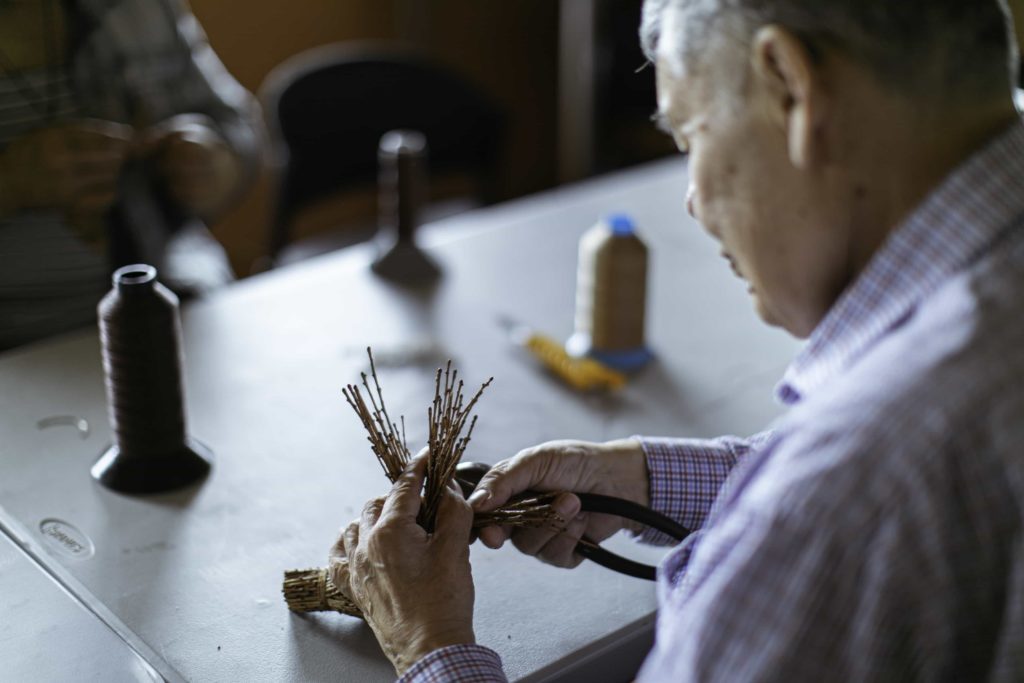There’s an urgency to transfer the stories from the Elders to the youth and create new ambassadors of the teachings and stories for the next generation.”
Nadine St-Louis
With the world seeming to spin a little faster with each passing year, finding the time to connect to the land and traditional ways can be challenging. A two-part cultural revitalization project called “NISK and stories from the land” was created to address this need, beginning with an intergenerational residency in Ouje-Bougoumou July 22-26.
“We never have enough opportunities to create that space where the youth and Elders sit together and really take that time to connect, listen, share and practice,” said organizer Nadine St-Louis. “There’s an urgency to transfer the stories from the Elders to the youth and create new ambassadors of the teachings and stories for the next generation.”
St-Louis is the founder of Sacred Fire Productions and Ashukan Cultural Space in Montreal, which supports the inclusion and advancement of Indigenous artists in the arts marketplace.
“I said we need to go back to your territory and work with the youth and Elders,” St-Louis recalled. “The African proverb says that when an Elder dies, a library dies with them. Our Elders are carrying the stories of their great-great-grandparents. If we’re not listening to them, we’ll forget them.”

After Maïtée Labrecque-Saganash helped St-Louis spread the word, five young women gathered for five days of traditional teachings and cultural activities in Cree. Thomas and Josephine Coon shared stories from their upbringing with a collection of old photos, presenting where the culture has come from and emphasizing the importance of new leaders to carry it forward.
“From the first day, I noticed they were a very motivated group,” Thomas Coon noted. “They were very eager to listen, to understand. I’m always trying to plant a seed in the young Crees so they can get actively involved, get their education and come back and work for their people.”
As Harold Bosum taught the group how to pick tamarack and make decoys on Day 2, Coon would share stories of the Nisk (goose) that go back centuries or even millennia. Other highlights included artist Tim Whiskeychan demonstrating painting techniques with goose feather and the final day’s feast at Anna and David Bosum’s cultural camp.
“There were few of us, but it was a powerful few,” said Josée Bernier. “It went well beyond what I was expecting. We did a lot of sharing circles – there was truly a sense of family after just the first meeting. Hearing Thomas speak reminded us of our roots and how much we need to keep that alive.”
Bernier was particularly drawn to the project’s combination of storytelling and art, which include curating an exhibition on the importance of reclaiming culture, to be launched at the Ashukan Cultural Space in November.

This multimedia installation will include world-class photography of the residency from Nadya Kwandibens, tamarack geese and other cultural objects, and a giant mural based on stories shared during the week that Whiskeychan will create alongside Vanessa Stephen, a young artist from Waskaganish.
“The first part (of the project) is super important for the connection, but the second part, doing an art exhibit with them is showing the power of the arts,” explained St-Louis. “Through culture and the arts we can bring awareness to a lot of people about the beauty of the culture, about the resiliency of the youth, about the importance of its survival and its resistance.”
During the residency, Bernier made audio recordings of the Elders’ teachings, which will become both part of the exhibition and also the beginning of a forthcoming cultural language archive. They intend to speak with many people in Eeyou Istchee in the coming months, gathering traditional stories and special experiences to develop this communal archive.
“We’ll be able to share these archives with the younger generation 50 years down the road and they’ll be able to listen to how alive the language still is,” Bernier observed. “We’re fighting hard to keep our language. Most of our Elders only speak Cree. It’s so vital that the younger generation grows up knowing their language so there is no barrier between the younger and older generation.”
More than merely developing leadership capabilities, the project revealed an inherent responsibility to inspire others to become cultural knowledge keepers.
“There’s so much power in mobilizing small groups of young people who want to do the work,” enthused St-Louis. “To be a leader you need to know your history, you need to feel confident in your identity.”

Participants have told her that the project has inspired them and now the challenge is to keep it alive. They intend to expand the circle by making this an annual event with each youth bringing another person next year.
“I would encourage anybody to take any opportunity they can to strengthen that relationship, whether that’s going out on the land or through art or music, do whatever it takes to keep your culture and identity alive,” said Bernier. “Our ancestors fought so hard for us to be here so we are living legacies. Let us honour that.”





